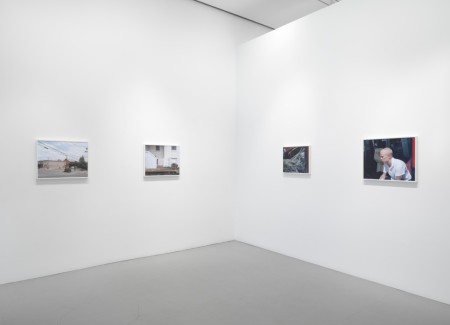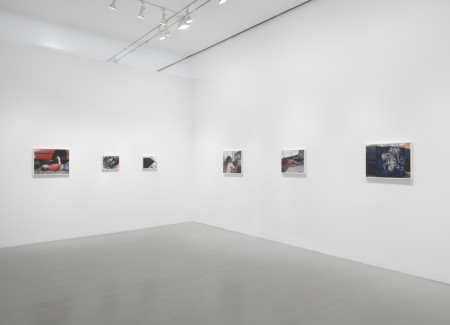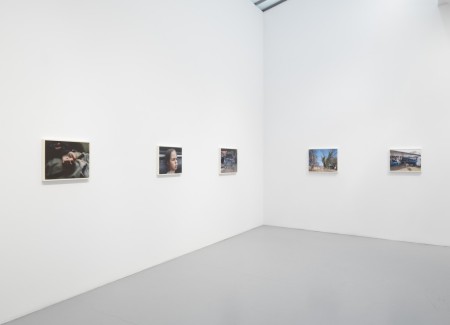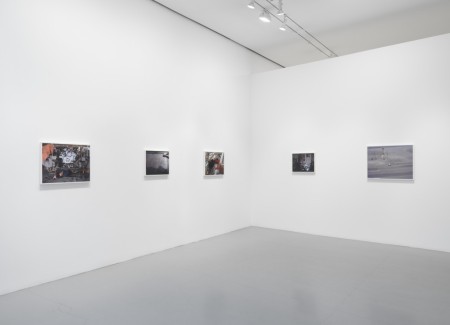JTF (just the facts): A total of 36 color photographic works (35 single images and 1 diptych), framed in white and unmatted, and hung against white walls in a series of three interconnected spaces. All of the works are inkjet prints, made between 2011 and 2014. Physical sizes range from 11×14 to 24×30 (or reverse), and all of the images are available in editions of 6. A self published catalog of the exhibit is available from the gallery for $40. (Installation shots below, courtesy of Mitchell-Innes & Nash.)
Comments/Context: Justine Kurland’s new exhibit documents the slowly decay of the masculine swagger that once defined the love affair between American men and their cars. Unlike her previous body of work which chronicled the romance of a nomadic wandering life among trains, her recent pictures harbor far fewer self-deceiving illusions, placing the rougher reality of the greasy repair shop and the smashed carcass of the junk yard up against the grand and glorious freedoms of the open road. These are not photographs that recall the clean cut cool of the 1950s, that revel in the muscular machismo of tricked out hot rods, vans, or low riders, or that celebrate the fetish status symbols of the concours d’elegance classic car set, but instead focus on something more modest and intimate, now found amid the oil slicks and cracked pavement of forgotten parking lots and garages. Her pictures are like a period at the end of a long sentence, a last weary gasp of a now outdated brand of petroleum-based American optimism.
If there is any one theme to Kurland’s collective portrait of men and cars, it is a kind of burnt out tenderness, where things that are broken are slowly and meditatively fixed by those who care enough to spend the time to rebuild them. Men crawl under engine blocks (alone and in pairs), laying down in the grit and happily caressing the objects of their affection, Kurland capturing the quietly proud gestures of an arm holding up a hood or a greasy hand working a pump. Engines sit on pedestals like treasured sculptures, intricate gears and chromed parts ready for further inspection. Time passes slowly, afternoons filled with tinkering, and testing, and talking, and dreaming, the clank of metal on metal the only disruption of the easy going silence. Unexpected beauty is found in the small moments, like a slice of watermelon perched in a tire shop, or the headlights of a junked car framed perfectly by the window of an abandoned car door, or even the draped fold of a spiderwebbed windshield.
In contrast to this humble glow, Kurland places a seemingly equal number of photographs that dive deeper into a darker mood of melancholy and faded bravado. The fire breathing skulls of a custom paint job and the white tigers of a carpet feel like sad, worn out clichés, their awesomeness now the domain of irony rather than power. Tattooed men sit behind the wheel, holding gleaming rims or stepping out with black leather gloves and metal bracelets, imagining better days. Even a once ferocious wolf on a chain now seems bored and tamed, like any other neighborhood dog on a leash. Men are left to loiter around in defiance of posted signs and traffic cops, with little to do but stare at the smashed windshields and chunked concrete. A Fight Club kind of frustration lingers in the background.
A set of images along the back wall brings Kurland’s son Casper (a frequent subject of her previous work) back into the visual conversation, turning the traditional aggressiveness of men and cars on its head and bringing male vulnerability to the forefront. Casper nestles in his car seat in the front seat of the family van, the puzzlingly dangerous location turning into a violently smashed windshield in an adjacent picture (fittingly entitled Death Seat). Her son’s broken tooth and a bored spit bubble come in the next images in the sequence, punctuated by a completely destroyed front end of a car. It’s clear that in the company of these vehicles, this young boy can no longer be protected by his mother. Nearby images of a fragile roadkill sparrow and similarly broken and disoriented men paint a grim picture of beaten down frailty.
If there way ever an enduring symbol of the American passion for all that cars represent, it is that timeless photograph of an endlessly open road stretching out ahead of us (Robert Frank, Dorothea Lange, and Robert Adams among many others have made great images of this subject). These pictures have come to stand for American freedom and self reliance, for our ability to take life into our own hands and head out for somewhere new on a glamorous and exciting Kerouacian road trip; it’s the frontier spirit writ large. In Kurland’s show, however, the road doesn’t beckon us with its big skies and vast future; her road is hemmed in, cropped down to an empty concrete space interrupted by disorienting painted lines. This road doesn’t epitomize romance, it offers instead bewildering, going nowhere confusion.
Seen together (and I think the photographs function best in sequence and as a complete body of work), Kurland has crafted a deceptively powerful portrait of the aftermath of strutting arrogance and car-centered culture, where men have traded their brashness (in some cases grudgingly) for more unpretentious, inward looking attitudes. She’s consciously walking the knife edge of ugliness and beauty here, mostly falling down on the side of quiet (but sincere) disillusionment, where the light reflecting off a pool of oil can be lovely for just a moment, before it resolves back into a forgettable dirty puddle. Kurland has upended and reconsidered our closely held beliefs about what cars might mean to contemporary American men, and done so with grace and subtlety.
Collector’s POV: The works in this show are priced between $3500 and $7500 based on size. Kurland’s work has slowly begun to enter the secondary markets in the past few years, with prices ranging from roughly $2000 to $6000.










